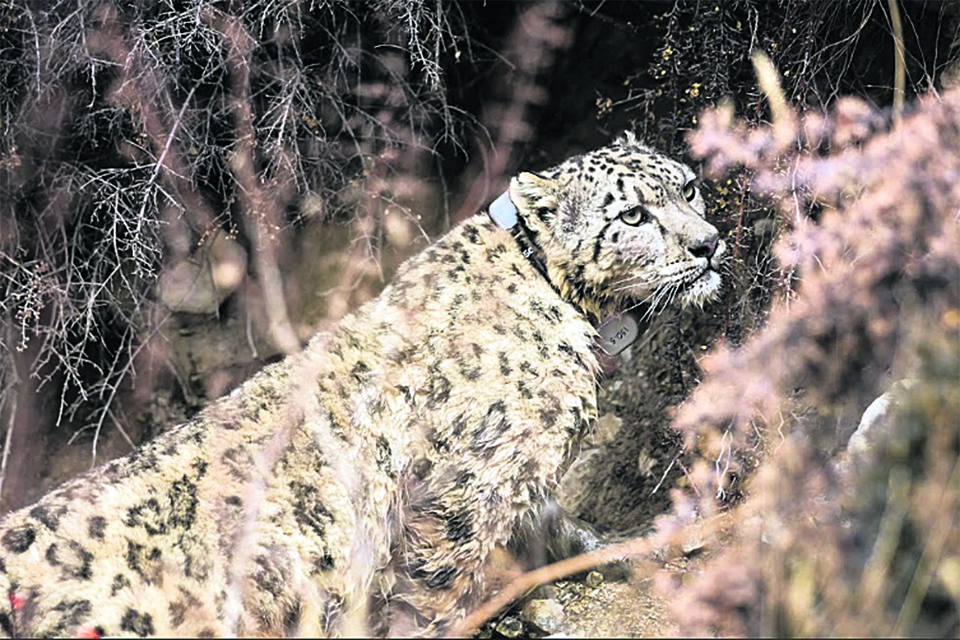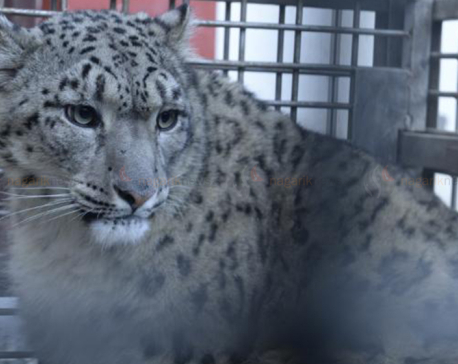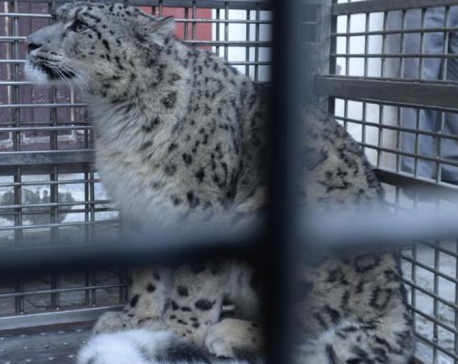
OR
GPS collars fitted on two snow leopards in Dolpa
Published On: November 30, 2019 10:50 AM NPT By: Republica | @RepublicaNepal

KATHMANDU, Nov 30: Two snow leopards were successfully collared with GPS devices in mid-November in Bhijer of Shey Phoksundo National Park in Dolpa district in Karnali province.
Captured at 4,171 meters in Charkarbo, the first of the two snow leopards weighed 38 kgs and has been was named Zeborong after the local Snow Leopard Conservation Committee.
The second leopard has been named Shyamling, after the Shyamling Gumba [monastery], the oldest monastery in Dolpa. Shyamling was captured at 3,885 meters in Ngyong and it weighed 33 kgs. Both the snow leopards are male.
They were fitted with satellite-GPS collars and released back into the wild.
“The Western Himalayan Landscape is a priority landscape, with Dolpa having the largest snow leopard population in Nepal. And the use of satellite telemetry collaring in research and monitoring will help in the conservation of these iconic species in the landscape,” stated Dr Bishwanath Oli, secretary at the Ministry of Forests and Environment.
Gopal Prakash Bhattarai, Director General of the Department of National Parks and Wildlife Conservation stated that, “The data generated from these collars will be crucial in understanding the spatial ecology of snow leopards in this landscape while also bridging the existing information gaps in the Western Himalayan Landscape.”
After wildlife biologist Dr Rodney Jackson’s scientific radio collaring mission in the 1980’s to track snow leopards and learn about their habitats, this is the first time that a satellite telemetry expedition has been undertaken in the Western Himalayan Landscape.
Both Zeborong and Shyamling will be closely monitored by the government and conservation biologists. With almost no data from this terrain, conservationists are hopeful that the information received from the recent collaring, almost 40 decades later will help determine snow leopard movement patterns, habitat use and preferences, and home ranges in western Himalayas to identify critical habitats and corridors between them, including trans-boundary habitat linkages and climate resilient habitat for future conservation.
Ghana S Gurung, Country Representative of WWF Nepal said, “With growing infrastructural development across the country, information received from the collaring will be key in identifying implications of linear infrastructure in snow leopard habitats, human-snow leopard interface and mitigation measures.”
Gurung also mentioned that besides contributing toward the Global Snow Leopard and Ecosystem Protection Program (GSLEP), the data will also help determine how snow leopard conservation moves ahead in Nepal in the face of climate change.
You May Like This

Snow leopards fitted with ‘satellite GPS collar’
JAJARKOT, May 31: Satellite GPS collars have been installed in four snow leopards in Dolpa-based Shey Phoksundo National Park. ... Read More...

Rescued from Morang’s Urlabari, snow leopard now sheltered in air-conditioned enclosure at Lalitpur's Central Zoo
KATHMANDU, Jan 29: A wild animal which is considered rare in the world and found in Nepal is now in... Read More...

Snow leopard found in Morang shifted to central zoo (In Photos)
KATHMANDU, Jan 26: A snow leopard found in Urlabari of Morang has been shifted to the Central Zoo in Lalitpur. Read More...





Just In
- 286 new industries registered in Nepal in first nine months of current FY, attracting Rs 165 billion investment
- UML's National Convention Representatives Council meeting today
- Gandaki Province CM assigns ministerial portfolios to Hari Bahadur Chuman and Deepak Manange
- 352 climbers obtain permits to ascend Mount Everest this season
- 16 candidates shortlisted for CEO position at Nepal Tourism Board
- WB to take financial management lead for proposed Upper Arun Project
- Power supply to be affected in parts of Kathmandu Valley today as NEA expedites repair works
- Godepani welcomes over 31,000 foreign tourists in a year






_20220508065243.jpg)







Leave A Comment